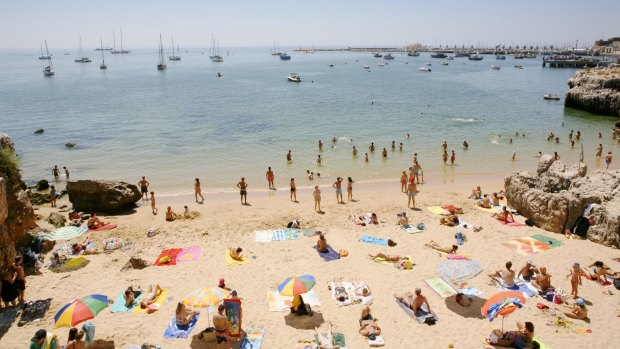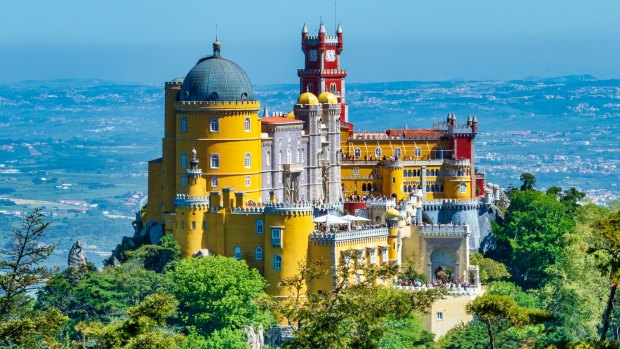This was published 4 years ago
Secluded beaches and Moorish castles off the beaten track in Portugal
By Ben Groundwater

Beaches of Sintra.Credit: Juliet White
They say there's no such thing as bad weather, just the wrong clothes. And I have the wrong clothes. I mean, I have the right clothes, but they're at home somewhere deep in a cupboard. Right now, right here, I have the wrong clothes, which means a T-shirt and shorts as the rain approaches in a damp curtain, as the wind whips through the treetops and fog closes in.
I clutch my arms across my chest and plod along with determination, trying to get the blood pumping. I laugh bitterly at my route notes, too, which speak of viewpoints, which say things like "to the left you'll be able to see the town of Cascais". Ha, I think. I can barely see my hand in front of my face. Plod, plod, plod.
But what a difference a day makes. Cut to 24 hours later and the sun is out in all its shining, warming glory. I'm standing atop the Pena Palace, the famed citadel in the mountain top town of Sintra, and I can see … everything. I can see the riotously coloured facade of this bold symbol of Portuguese power. I can see the palace's fairytale turrets and its cartoonish gargoyles. I can see the rolling, forest-covered scenery that surrounds the castle. And I can see the sky, as blue and unblemished as the distant ocean.

Extravagant Pena Palace in Sintra, Portugal. Credit: iStock
Today is a day to explore on foot. It's also a day when a T-shirt and shorts seem pleasingly appropriate. Already I've climbed from Sintra itself up a long, steep hill, through small villages and along cobbled paths, past the Castle of the Moors, an 8th-century ruin, and on into the park surrounding the palace. I spend the rest of this beautiful, warm afternoon traversing the park around Pena Palace, taking in the citadel's magnificence from every conceivable angle, enjoying a stroll through manicured gardens, around lakes and up hilltops, before eventually taking the steep descent back to Sintra.
To explain yesterday's poor choice of clothing: never look at a weather forecast for Lisbon and assume it applies to Sintra. The latter city might only be a 30-minute drive from the Portuguese capital, but it has a micro-climate all of its own; it's a mountain-top refuge that's long been popular with Lisbon's well-heeled as a place to cool off during the heat of summer. It might be 30 degrees and sunny down by the coast, but up in Sintra it could be drizzly and 18.
And so it was, and a bad thing as far as my choice of attire was concerned, but that variable climate, in general, is a positive in terms of what there is to see in Sintra. The settlement exists because of its weather: it's the perfect getaway from baking hot Lisbon, and over hundreds of years the area has gradually filled with all manner of grand estates, romanticist villas, luxury manors and royal palaces, to the point where it has gained a World Heritage listing as a unique cultural landscape.
Many travellers make this town a quick stop-off during their visit to Lisbon, but I'm spending four nights here as part of UTracks' Portugal Palaces and Coast self-guided walk. My journey is split into two sections: one focused on the high country around old Sintra, and the other on the coastal area that forms part of the Sintra municipality, the rugged cliffs and golden beaches of the Portuguese Riviera.
It sounds gorgeous, of course, and pleasingly warm. Except on day one there's that persistent drizzle and low cloud in Sintra, typical – my cab driver grunts – of this area. I make the march up to Pena Palace regardless, but I'm lost in a cloud, the dazzling colours of the 19th-century castle dulled to grey. The day after is more of the same, as I plod in that persistent rain through the forested hills of Sintra-Cascais Nature Park, pondering my inappropriate clothing, watching as the treetops bend in the strong wind, hiding my printed hiking notes lest they get too wet to read.
A self-guided walk means these hiking notes are your best friend. Your ticket to a hassle-free day that begins and ends where it should is the sheaf of instructions and drawings given to you at the beginning of the trip, with each day mapped out, and each walk divided into way points. They're actually quite easy to follow, and by far my biggest challenge on the first few days is keeping them dry.
But then the sun breaks out from behind its curtain of clouds, and life changes for the better in almost every way. I decide to redo the first day's trek to Pena Palace, enjoying the colours and the scenery the way they're supposed to be.
The following morning I begin the trek downhill towards the coast, leaving the mountaintop villas of Sintra and following a rough dirt track into the city's outskirts, past plenty of "quintas", or grand estates surrounded by high stone walls. Those estates change, I discover, as I move slowly closer to the coast: they become gradually newer and more contemporary in design, reflecting the creep from the traditional stronghold of the aristocracy into lands newly developed for Lisbon's nouveau riche.
And then the coast appears, windswept and interesting. The earth at Azenhas do Mar falls spectacularly into the sea, rugged cliffs buffeted by wind and waves. There's a gravel track that leads along the coastline, stately homes on one side, the heaving Atlantic on the other. I pick my way through wildflowers and over rocks, across a small beach and over stepping stones in a river before arriving at Praia Grande.
This is the second section of the trip, exploring the coastline on a series of fairly relaxed hikes, climbing up cliffs and skirting beaches on the way into the seaside resort town of Cascais. The weather along here is more like Lisbon, more like what I'd packed for, bright and sunny, the sort of place where a T-shirt and shorts once again feels like a reasonable and intelligent decision.
There's time to swim at secluded beaches, to grab lunch at little shacks by the coast, to stop for a beer at one of the many beachside kiosks. Eventually I'll arrive in Cascais, which hums with summertime activity, where holidaymakers relax on achingly perfect beaches or hang out in lively bars or explore the city's 15th-century citadel.
This is the place to rest weary legs, to sip a cocktail by the hotel pool and consider the way the classic grandeur of Sintra morphs into resort chic of Cascais, how it all links together, something you would only know if you took the time to walk here. It's a good chance, too, to appreciate the glory of wearing the right clothes.
FIVE MUST-VISIT SIGHTS IN SINTRA
PENA PALACE
The symbol of Sintra – indeed, the symbol of Portugal – is this brilliant, multi-hued edifice high in the hills. The Pena Palace looks like it was designed by Walt Disney, so ridiculous is its romanticist mix of styles, but there's no doubt it's an impressive sight.
CASTLE OF THE MOORS
Sharing a similar mountaintop location to the Pena Palace, the Castelo dos Mouros is an 8th century battlement built, as the name suggests, by Moorish settlers. On a clear day the view from the ramparts is stunning, taking in everything from the mansions of Sintra to the Atlantic.
PALACIO NATIONAL
As impressive as the Palacio National is from the outside, with its signature conical chimneys, this maze of a building is even more interesting inside. It's a timeline of Sintra's history, first built by the Moors, and added to by various Portuguese royals.
QUINTA DA REGALEIRA
This is the sleeper hit of Sintra, and some say the best of the town's palaces and villas. The mansion was dreamed up by Luigi Manini, an Italian opera-set designer, and is best known for its extensive gardens and its 27-metre-deep well, surrounded by a spiral stone staircase.
PALACIO MONSERRATE
Garden lovers will find their happy place at Monserrate Palace, with its 30 rambling hectares of parkland that lead to the dwelling itself, a mansion that was restored to its current glory by Englishman (and the 1st Viscount of Monserrate) Sir Francis Cook in the 1800s.
TRIP NOTES
Ben Groundwater travelled with assistance from UTracks.
MORE
FLY
Emirates Airlines flies from all major ports in Australia to Lisbon, via Dubai. See emirates.com
TOUR
UTracks' eight-day, self-guided Portugal Palaces and Coast walking holiday, which includes a detailed information pack with walking notes, seven nights' accommodation, seven breakfasts, private transfers to trail heads, and luggage transfers between hotels, costs from $970 a person. Tours depart daily year-round. See utracks.com
Sign up for the Traveller Deals newsletter
Get exclusive travel deals delivered straight to your inbox. Sign up now.